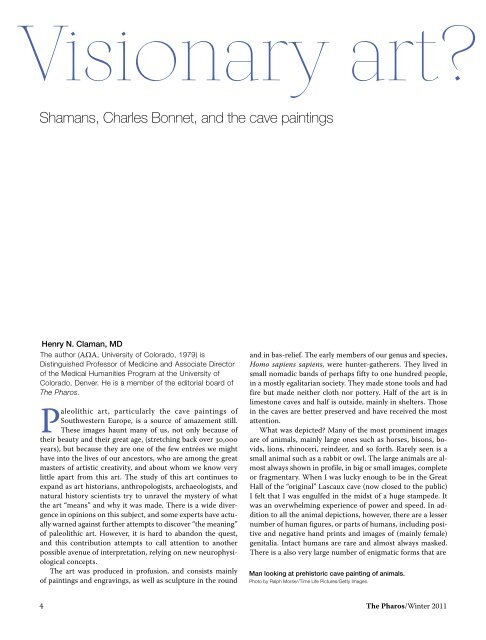Download The Pharos Winter 2011 Edition - Alpha Omega Alpha
Download The Pharos Winter 2011 Edition - Alpha Omega Alpha
Download The Pharos Winter 2011 Edition - Alpha Omega Alpha
Create successful ePaper yourself
Turn your PDF publications into a flip-book with our unique Google optimized e-Paper software.
Visionary art?<br />
Shamans, Charles Bonnet, and the cave paintings<br />
Henry N. Claman, MD<br />
<strong>The</strong> author (AΩA, University of Colorado, 1979) is<br />
Distinguished Professor of Medicine and Associate Director<br />
of the Medical Humanities Program at the University of<br />
Colorado, Denver. He is a member of the editorial board of<br />
<strong>The</strong> <strong>Pharos</strong>.<br />
Paleolithic art, particularly the cave paintings of<br />
Southwestern Europe, is a source of amazement still.<br />
<strong>The</strong>se images haunt many of us, not only because of<br />
their beauty and their great age, (stretching back over 30,000<br />
years), but because they are one of the few entrées we might<br />
have into the lives of our ancestors, who are among the great<br />
masters of artistic creativity, and about whom we know very<br />
little apart from this art. <strong>The</strong> study of this art continues to<br />
expand as art historians, anthropologists, archaeologists, and<br />
natural history scientists try to unravel the mystery of what<br />
the art “means” and why it was made. <strong>The</strong>re is a wide divergence<br />
in opinions on this subject, and some experts have actually<br />
warned against further attempts to discover “the meaning”<br />
of paleolithic art. However, it is hard to abandon the quest,<br />
and this contribution attempts to call attention to another<br />
possible avenue of interpretation, relying on new neurophysiological<br />
concepts.<br />
<strong>The</strong> art was produced in profusion, and consists mainly<br />
of paintings and engravings, as well as sculpture in the round<br />
and in bas-relief. <strong>The</strong> early members of our genus and species,<br />
Homo sapiens sapiens, were hunter-gatherers. <strong>The</strong>y lived in<br />
small nomadic bands of perhaps fifty to one hundred people,<br />
in a mostly egalitarian society. <strong>The</strong>y made stone tools and had<br />
fire but made neither cloth nor pottery. Half of the art is in<br />
limestone caves and half is outside, mainly in shelters. Those<br />
in the caves are better preserved and have received the most<br />
attention.<br />
What was depicted? Many of the most prominent images<br />
are of animals, mainly large ones such as horses, bisons, bovids,<br />
lions, rhinoceri, reindeer, and so forth. Rarely seen is a<br />
small animal such as a rabbit or owl. <strong>The</strong> large animals are almost<br />
always shown in profile, in big or small images, complete<br />
or fragmentary. When I was lucky enough to be in the Great<br />
Hall of the “original” Lascaux cave (now closed to the public)<br />
I felt that I was engulfed in the midst of a huge stampede. It<br />
was an overwhelming experience of power and speed. In addition<br />
to all the animal depictions, however, there are a lesser<br />
number of human figures, or parts of humans, including positive<br />
and negative hand prints and images of (mainly female)<br />
genitalia. Intact humans are rare and almost always masked.<br />
<strong>The</strong>re is a also very large number of enigmatic forms that are<br />
Man looking at prehistoric cave painting of animals.<br />
Photo by Ralph Morse//Time Life Pictures/Getty Images.<br />
4 <strong>The</strong> <strong>Pharos</strong>/<strong>Winter</strong> <strong>2011</strong>














